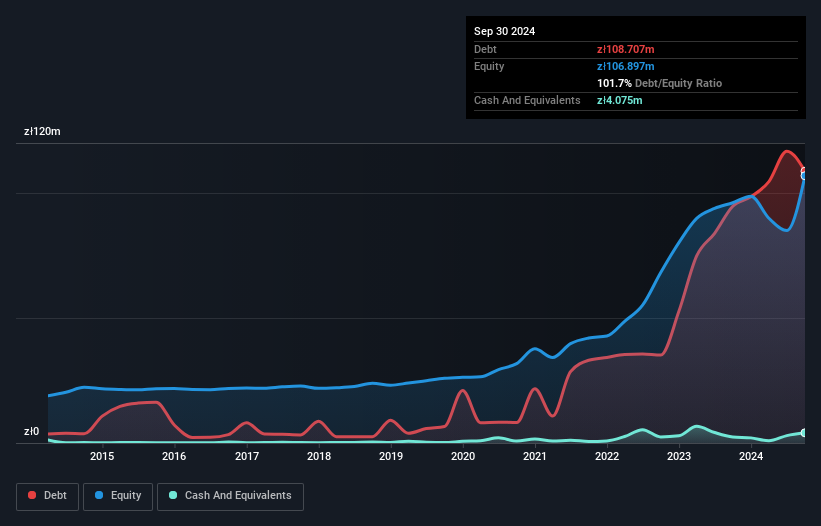
The external fund manager backed by Berkshire Hathaway's Charlie Munger, Li Lu, makes no bones about it when he says 'The biggest investment risk is not the volatility of prices, but whether you will suffer a permanent loss of capital.' So it might be obvious that you need to consider debt, when you think about how risky any given stock is, because too much debt can sink a company. Importantly, Sunex S.A. (WSE:SNX) does carry debt. But the more important question is: how much risk is that debt creating?
When Is Debt A Problem?
Generally speaking, debt only becomes a real problem when a company can't easily pay it off, either by raising capital or with its own cash flow. If things get really bad, the lenders can take control of the business. However, a more usual (but still expensive) situation is where a company must dilute shareholders at a cheap share price simply to get debt under control. Of course, debt can be an important tool in businesses, particularly capital heavy businesses. The first thing to do when considering how much debt a business uses is to look at its cash and debt together.
How Much Debt Does Sunex Carry?
As you can see below, at the end of September 2024, Sunex had zł108.7m of debt, up from zł94.7m a year ago. Click the image for more detail. On the flip side, it has zł4.08m in cash leading to net debt of about zł104.6m.

How Healthy Is Sunex's Balance Sheet?
According to the last reported balance sheet, Sunex had liabilities of zł110.3m due within 12 months, and liabilities of zł73.6m due beyond 12 months. On the other hand, it had cash of zł4.08m and zł38.4m worth of receivables due within a year. So its liabilities outweigh the sum of its cash and (near-term) receivables by zł141.5m.
This deficit is considerable relative to its market capitalization of zł162.3m, so it does suggest shareholders should keep an eye on Sunex's use of debt. Should its lenders demand that it shore up the balance sheet, shareholders would likely face severe dilution. When analysing debt levels, the balance sheet is the obvious place to start. But you can't view debt in total isolation; since Sunex will need earnings to service that debt. So when considering debt, it's definitely worth looking at the earnings trend. Click here for an interactive snapshot.
Check out our latest analysis for Sunex
Over 12 months, Sunex made a loss at the EBIT level, and saw its revenue drop to zł201m, which is a fall of 43%. That makes us nervous, to say the least.
Caveat Emptor
Not only did Sunex's revenue slip over the last twelve months, but it also produced negative earnings before interest and tax (EBIT). Indeed, it lost zł16m at the EBIT level. Considering that alongside the liabilities mentioned above does not give us much confidence that company should be using so much debt. Quite frankly we think the balance sheet is far from match-fit, although it could be improved with time. However, it doesn't help that it burned through zł20m of cash over the last year. So in short it's a really risky stock. When analysing debt levels, the balance sheet is the obvious place to start. But ultimately, every company can contain risks that exist outside of the balance sheet. To that end, you should learn about the 4 warning signs we've spotted with Sunex (including 1 which is potentially serious) .
At the end of the day, it's often better to focus on companies that are free from net debt. You can access our special list of such companies (all with a track record of profit growth). It's free.
New: Manage All Your Stock Portfolios in One Place
We've created the ultimate portfolio companion for stock investors, and it's free.
• Connect an unlimited number of Portfolios and see your total in one currency
• Be alerted to new Warning Signs or Risks via email or mobile
• Track the Fair Value of your stocks
Have feedback on this article? Concerned about the content? Get in touch with us directly. Alternatively, email editorial-team (at) simplywallst.com.
This article by Simply Wall St is general in nature. We provide commentary based on historical data and analyst forecasts only using an unbiased methodology and our articles are not intended to be financial advice. It does not constitute a recommendation to buy or sell any stock, and does not take account of your objectives, or your financial situation. We aim to bring you long-term focused analysis driven by fundamental data. Note that our analysis may not factor in the latest price-sensitive company announcements or qualitative material. Simply Wall St has no position in any stocks mentioned.
About WSE:SNX
Sunex
Manufactures and sells solutions based on renewable energy sources in Poland.
Low risk and overvalued.
Market Insights
Community Narratives





